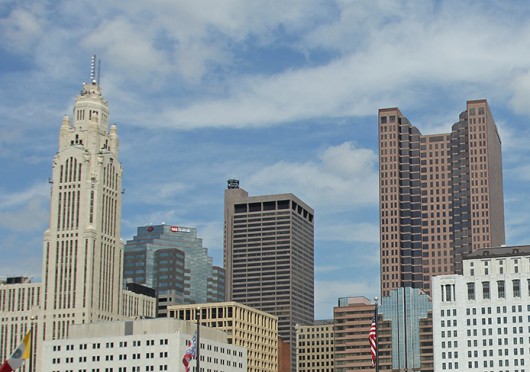
According to the Environmental Protection Agency’s Top 30 Local Government list, a list measuring the top city governments using green power across the country, Columbus ranks No. 13 in terms of green energy use. Credit: Lantern file photo
Thirteen might be an unlucky number for some, but for city officials, university professors and some students, it’s an accomplishment.
According to the Environmental Protection Agency’s Top 30 Local Government list, a list measuring the top city governments using green power across the country, Columbus ranks No. 13 in terms of green energy use. The list is updated quarterly, and measures energy usage in kilowatt-hours, according to the EPA’s website.
This quarter’s report, released Jan. 26, is the first time Columbus has ranked on the list, according to a city of Columbus press release.
In Columbus, 14 percent of electricity came from green sources, and the city has an annual usage of 42.4 million kilowatt hours from green energy. Green energy sources are “electricity produced from solar, wind, geothermal, biogas, eligible biomass and low-impact small hydroelectric sources,” the release said.
The point of the list is to recognize top users of green energy and inspire other cities and municipalities, said Anthony Amato, a renewable energy consultant at Eastern Research Group, a contract firm of the EPA.
City officials said they were pleased with ranking.
“This ranking shows that the city of Columbus is looking to reduce the environmental impact that electricity production can have. It also shows that green power can be economically feasible, and at 14 percent, it shows the city of Columbus is off to a good start,” said Erin Miller, Columbus’s environmental steward.
Though the ranking measures the city government’s usage of green power, OSU students in the environment, economy, development and sustainability major have found a way to be involved.
“This year, we have 45 students in the capstone class, and our relationship is really good with the city. We’ve put together this arrangement where we take certain actions from the Green Memo III, and package those into projects,” said Neil Drobny, program director of EEDS.
Green Memo III is the city’s five-year strategic outline for becoming more energy efficient. The first Green Memo was launched by Mayor Michael Coleman in 2000.
The Memo outlines its goals in nine categories, ranging from local food access and security to waste reduction. This year’s student capstone projects are focused on the climate change category, specifically on greenhouse gas emissions, Drobny said.
“The goal will be for the students to figure out, in a little more detail, how these different actions (in the Memo) can be executed, what it’s going to take in the way of information, money, cooperation, and what it’s going to yield in benefits,” he said.
However, this isn’t the first time the university and the city have teamed up for the environment. The dam at 5th Avenue, which was removed in 2012, was a project both the university and the city worked on with joint jurisdiction, said Greg Hitzhusen, a lecturer at the College of Food, Agricultural and Environmental Studies.
The university subsequently has started to work around the Olentangy River, not only to increase campus green space, but also to work toward ecological restoration, Hitzhusen said.
“There’s a lot of influence coming from Ohio State,” Hitzhusen said, in reference to Columbus and OSU working together on environmental tasks.
Scott Semroc is one of the EEDS students working with the city on its Green Memo, specifically on energy management for city buildings.
“I think government is really starting to see that they owe it to the people that they represent to make (the environment) more of a priority than they have in the past,” said Semroc, a fourth-year in EEDS.
Additionally, citizens are starting to take notice of government work related to the environment, Semroc said. He added that he thinks people will be looking to live in a city known to be sustainable.
“It’s a big focus nowadays, and hitting a list like that is a really big deal because (Columbus) is getting compared to some of the really big cities like New York and L.A.,” he said.


